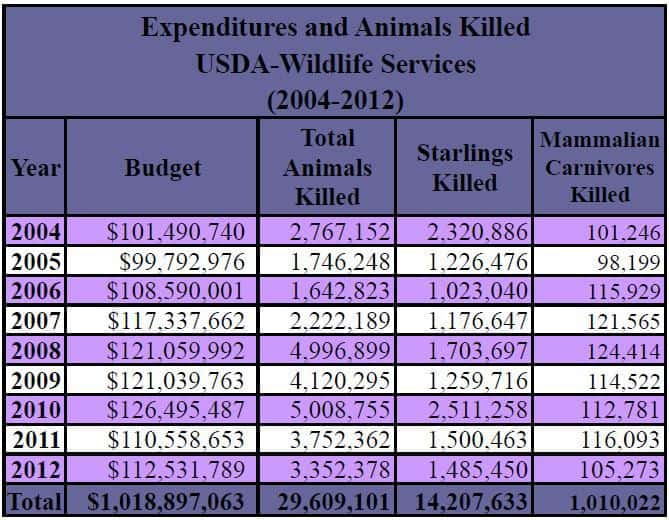Historical Archive for Reference Only
Wildlife Services funding and expenditures 2004-2012
Wildlife Services funding and expenditures 2004-2012
“Wildlife Services,” a secretive arm of the U.S. Department of Agriculture, annually kills millions of animals. In 2011, the agency reported it killed 3.8 million animals, a 25 percent decrease from FY 2010, although the largest decline is represented in one million fewer non-native starlings killed, while agents killed greater numbers of mammalian carnivores, especially coyotes and raccoons.
The veracity of Wildlife Services’ kill numbers is always suspect. It is a secretive agency that uses unknown data collection techniques and is politically motivated to undercount the number of animals their agents kill with the hopes that no one will notice.
“Guys who kill non-target animals don’t report it,” said Gary Strader, a former Wildlife Services agent. “There’s not a fraction of the non-target kills reported by the guys in the field. Figures lie and liars figure.”

Wildlife Services came under fire in April and May 2012. First, the Sacramento Bee published a critical series of articles and an editorial exposing the agency’s killing programs. Then, WildEarth Guardians filed a lawsuit that challenged the agency’s 18-year-old management guidance as flawed and devoid of modern scientific principles, and for operating aerial-gunning craft in designated wilderness areas. Third, a federal district court in New Mexico ordered Wildlife Services to produce budgetary information and other data as part of Guardians’ ongoing litigation under the Freedom of Information Act. Finally, thousands of Americans have contacted their Congressional representatives in the past month requesting that Congress investigate Wildlife Services and cut the agency’s budget.
“The misnamed Wildlife Services is a carpet bomber of the West because of the scale of indiscriminate killing of native wildlife,” said Jim Baca, former director of the Bureau of Land Management in the 1990s. “If Congress is serious about saving money, this is where they should start.”
Wildlife Services reported it killed nearly 1,400 house cats, more than 400 domestic dogs, 14 American white pelicans, and 2,983 meadowlarks in FY 2011. Other notable changes from the previous year include:
- The number of raptors (hawks, falcons, owls, and vultures) killed increased from 7,798 in FY 2010 to 11,061 in FY 2011, representing a 42 percent increase.
- Mammalian carnivores (wolves, coyotes, bears, bobcats, fishers, cougars, weasels, skunks, raccoons, and foxes) killed increased by three percent from FY 2010, from 112,781 to 116,093, with the greatest increases in the numbers of coyotes and raccoons killed.
- The number of animals poisoned by cyanide M-44s increased by a whopping 31 percent from FY 2010 from 14,155 to 18,587, with the biggest increases in coyotes killed: 2,300 more coyotes than the previous year. The numbers of animals reported killed by Compound 1080 dropped to 17 from previous years’ (2008 to 2010) average of 27. (These two poisons have been the subject of regulatory review by the Environmental Protection Agency after Guardians petitioned for a ban these toxicants in 2007 (with a decision expected next year), and now as part of a bill pending in Congress.)
- The number of animals killed by aerial gunning increased from 42,431 to 48,811 (15 percent), with the greatest increase in the number of hogs shot from aircraft. Notably one cougar was reported killed by aerial gunning in Texas. (Wildlife Services has never before recorded aerial gunning cougars, although a former employee has contented the agency engages in the practice part of a whistleblower lawsuit against the agency.)
The mammalian carnivore with the greatest level of exploitation was again coyotes, with 83,695 killed in FY 2011 (a 3 percent increase from 81,035 killed in FY 2010). Most coyotes were killed by: shot from aircraft (32,758); trapped/snared (21,618); or poisoned by sodium cyanide M-44 booby traps (15,217). Wildlife Services also eradicated 453 coyote dens that sheltered coyote pups.
Wildlife Services spends millions of taxpayer dollars on killing coyotes, a practice that has increased coyotes’ range by threefold in its 100-year history. Killing coyotes must be like a drug addiction for them – they just cannot stop even though it’s really unhealthy, unfruitful, and puts the public and their agents in harm’s way.
